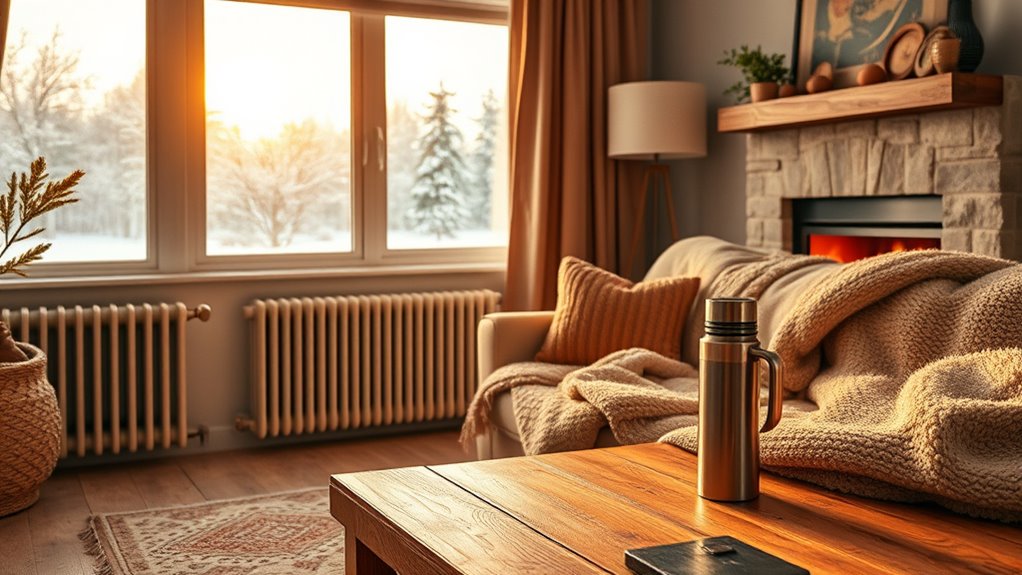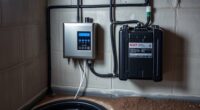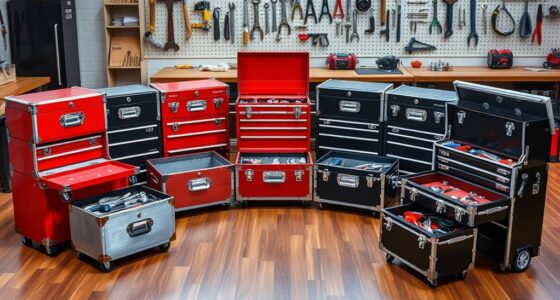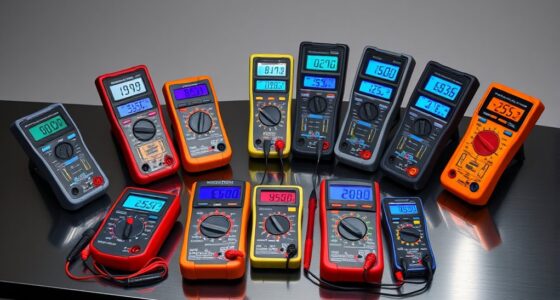To keep warm and cut costs this winter, I focus on sealing drafts around windows and doors, adding insulation, and using reflective window covers to boost heat retention. I also recommend setting up draft stoppers, using thermal curtains, and smart heating devices to target warmth efficiently. Monitoring energy use and maintaining equipment regularly help save even more. If you want a full list of practical tips, there’s plenty more you can try to cozy up without overspending.
Key Takeaways
- Seal gaps around windows and doors to prevent heat loss and improve indoor warmth.
- Add or upgrade insulation in walls, attics, and floors to retain heat effectively.
- Use draft stoppers and reflective window insulation to block cold drafts and reflect radiant heat.
- Optimize heating devices with programmable thermostats and zone heating for targeted warmth.
- Regularly maintain HVAC systems and monitor energy use to identify savings opportunities.
Insulate and Weatherize: For Energy Efficiency at Home
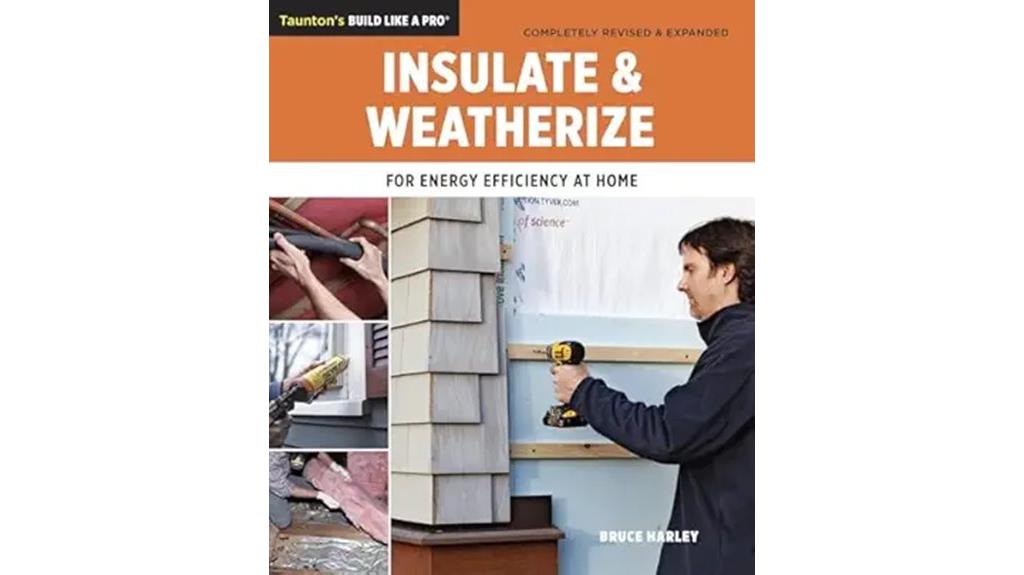
Are you looking to cut your winter energy bills while staying comfortable at home? Insulating and weatherizing are key steps. Proper insulation prevents warm air from escaping and cold air from sneaking in, making your heating more effective. Weatherization seals gaps around windows, doors, and vents, maintaining consistent indoor temperatures. Modern science offers better solutions to address airflow and energy loss. By upgrading insulation and sealing leaks, you’ll reduce energy waste, lower bills, and stay cozy all winter. Combining these efforts with efficient systems and smart upgrades makes your home more comfortable and environmentally friendly.
Best For: homeowners seeking to reduce winter energy bills, improve home comfort, and lower environmental impact through effective insulation and weatherization solutions.
Pros:
- Significantly lowers heating costs by preventing heat loss and air leaks.
- Improves indoor comfort and temperature stability year-round.
- Enhances overall home energy efficiency with modern insulation and sealing techniques.
Cons:
- Initial installation costs can be high depending on the scope of insulation upgrades.
- Proper sealing and insulation require professional assessment and installation for best results.
- May require periodic maintenance or upgrades as materials age or building needs change.
DIY Winter-Proof Home Guide

If you’re looking to stay warm and cut costs this winter without hiring expensive contractors, the DIY Winter-Proof Home Guide is your go-to resource. It offers practical, budget-friendly strategies to improve your home’s resilience against harsh weather. From sealing leaks and boosting insulation to installing emergency heat sources, these step-by-step tips are designed for immediate action. With guidance from home efficiency experts, you can transform your space into a cozy, reliable haven. These simple DIY solutions help reduce heating bills, increase comfort, and enhance safety during extreme winter conditions—all without breaking the bank.
Best For: homeowners seeking budget-friendly, DIY methods to enhance winter home resilience, warmth, and safety without professional help.
Pros:
- Cost-effective solutions that save money on heating and repairs
- Easy-to-follow, step-by-step instructions suitable for DIY beginners
- Improves home comfort and safety during extreme winter conditions
Cons:
- May require some basic tools and materials to implement effectively
- Results depend on proper execution; DIY mistakes could reduce effectiveness
- Not a substitute for professional assessments in cases of major home issues
13 Energy Saving Tips for Winter 2023 Plus Bills Tracker

Anyone looking to cut winter energy costs will find the “Energy Saving Tips for Winter 2023 Plus Bills Tracker” especially useful. This guide offers practical advice to reduce energy use, like optimizing heating, sealing drafts, and switching to energy-efficient lighting. It also includes a 12-month bills tracker to monitor your consumption and expenses, helping you spot patterns and measure savings. By implementing these tips and tracking your bills, you’ll better manage your winter energy budget and avoid surprises. Plus, the additional resources and reminders guarantee you stay on track, making it easier to stay warm and save money during the colder months.
Best For: households aiming to reduce winter energy bills through practical tips and expense tracking to manage their energy consumption effectively.
Pros:
- Provides actionable advice to cut energy use and lower bills during winter.
- Includes a 12-month bills tracker to monitor and analyze consumption patterns.
- Offers additional resources like checklists and reminders to keep users motivated and organized.
Cons:
- May require initial effort and time to implement all recommended energy-saving measures.
- The effectiveness of tips can vary depending on individual home insulation and energy systems.
- Additional tools or resources might not be accessible without further investment or subscriptions.
The Ultimate Smart Lighting Gift Guide for 2025

Looking to impress friends and family with thoughtful, high-tech holiday gifts? Smart lighting is the perfect choice for creating cozy, festive atmospheres while saving energy. My ultimate gift guide for 2025 features smart bulbs, plugs, and lighting strips that easily sync with Alexa, Google, Siri, or Matter-enabled devices. They’re simple to install, set up, and control—from automations to custom scenes—making holiday decorating effortless. Plus, smart lighting isn’t just fun; it’s practical, helping reduce energy bills and enhance safety. Whether for Christmas or New Year’s, these gifts transform any home into a warm, memorable space, all while being budget-friendly.
Best For: Homeowners seeking easy-to-install, energy-efficient smart lighting solutions to create festive atmospheres during holidays and beyond.
Pros:
- Seamless integration with Alexa, Google, Siri, and Matter-enabled devices for versatile control
- Simple installation and setup suitable for beginners and tech enthusiasts alike
- Enhances safety and energy savings while enabling creative automation and scenes
Cons:
- Initial cost may be higher than traditional lighting options
- Compatibility issues could arise with older or less common smart home systems
- Dependence on Wi-Fi or smart hub connections may lead to occasional delays or disconnections
Reflective Aluminum Foil Bubble Insulation Roll
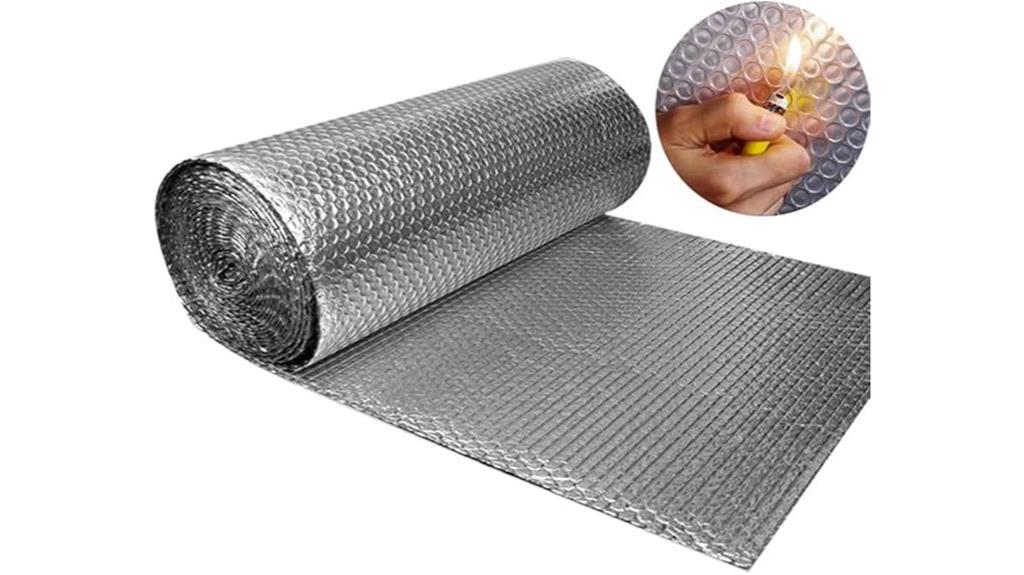
The Reflective Aluminum Foil Bubble Insulation Roll is an excellent choice for homeowners seeking an effective radiant barrier that boosts energy efficiency during winter. Made of fireproof, weatherproof, reflective aluminum foil, it reflects 95% of radiant energy, helping to retain heat inside your home. Easy to cut and install, it’s perfect for insulating windows, walls, floors, and more. The roll covers 38 square feet and comes with double-sided adhesive tapes for secure placement. While folding may cause creases initially, they tend to rebound over time. This versatile insulation improves warmth, reduces heating costs, and enhances privacy—making it a smart winter upgrade for any space.
Best For: homeowners and DIY enthusiasts seeking an easy-to-install, weatherproof insulation solution to improve energy efficiency, heat retention, and privacy during winter and summer.
Pros:
- Reflects 95% of radiant energy, enhancing thermal performance
- Easy to cut, install, and clean with included adhesive tapes
- Versatile and suitable for various applications such as windows, walls, floors, and HVAC systems
Cons:
- Folding during packaging can cause creases that may take time to rebound
- Slightly heavy at 1 pound, requiring secure fixing for larger areas
- May need additional sealing or insulation for extreme weather conditions
Window Air Conditioner Insulation Panels (2 Pieces, 17×10 Inches, EVA Foam)

These window air conditioner insulation panels are a smart choice for anyone aiming to boost their home’s energy efficiency during winter. Made from durable EVA foam, they fit most 5000-12000 BTU units and can be easily customized with scissors. The two panels, measuring 17 by 10 inches each, help seal gaps around the AC, preventing cold air from entering and warm air from escaping. They also block dust and pollen, improving indoor comfort. Installation is simple with double-sided nano tape, making it a quick DIY upgrade. Overall, these panels are an affordable way to enhance insulation and cut heating costs during the colder months.
Best For: homeowners and renters looking to improve their window air conditioner’s energy efficiency and indoor comfort during winter and summer.
Pros:
- Easy to install with DIY-friendly double-sided nano tape and scissors.
- Effectively seals gaps to prevent heat loss, drafts, dust, and pollen intrusion.
- Made from durable EVA foam, ensuring long-lasting insulation performance.
Cons:
- No edging strip included, which may require additional materials for a finished look.
- Fits window frames up to 39 inches wide, so may not suit larger windows.
- May need trimming for perfect fit on irregularly shaped or non-standard window frames.
NABOWAN 38″ Weighted Under Door Draft Stopper

If you want an easy, effective way to keep drafts out and improve your home’s energy efficiency, the NABOWAN 38″ Weighted Under Door Draft Stopper is an excellent choice. Its premium triangular design fits snugly against the floor and door, blocking cold air, noise, and odors. Made from durable polyester wadding filled with glass beads, it stays soft yet heavy enough to stay in place. Its flexible design works on all floor types, and the hook-and-loop fasteners prevent movement during door operation. Simply slide it under your door to help keep your home warmer in winter and reduce energy costs year-round.
Best For: homeowners seeking an easy, effective, and affordable solution to block drafts, noise, and odors from under doors while enhancing energy efficiency.
Pros:
- Easy to install with hook-and-loop fasteners, ensuring a secure fit during door operation
- Universally compatible with all floor types including carpet, tile, wood, and vinyl
- Heavyweight polyester wadding filled with glass beads provides durability and stability without sacrificing softness
Cons:
- May not fit doors longer than 38 inches or cover larger gaps beyond 3 inches
- Requires proper placement to prevent slipping or movement over time
- Potential wear on hook-and-loop fasteners with frequent use or over extended periods
24″ x 10 ft Reflective Window Insulation Roll for RVs, Attics, Garages

A 10 ft reflective window insulation roll is an excellent choice for anyone looking to boost their home’s energy efficiency during winter. Made of double aluminum foil and polyethylene bubble, it reflects up to 95% of radiant energy, helping keep heat inside. Its versatile design makes it perfect for RVs, attics, garages, windows, and walls. Installation is straightforward with self-adhesive pads, though it’s best on flat surfaces. Not only does it help reduce heating costs, but it also provides soundproofing and privacy. Folded in packaging, creases will diminish over time, and customer support is always available if needed.
Best For: homeowners, RV owners, and DIY enthusiasts seeking an easy-to-install solution to improve energy efficiency and thermal insulation in residential or mobile spaces.
Pros:
- Reflects up to 95% of radiant energy, effectively reducing heat transfer
- Versatile application for windows, attics, garages, RVs, walls, and floors
- Easy to install with self-adhesive pads; cuts and maintains easily
Cons:
- May have creases from folding in packaging that diminish over time
- Not suitable for uneven surfaces, limiting installation options in some areas
- Adhesive pads are best on flat surfaces, which may restrict certain mounting surfaces
Comfort Zone Indoor Space Heater with Thermostat

The Comfort Zone Indoor Space Heater with Thermostat is an excellent choice for anyone looking to customize their indoor warmth while saving energy. Its adjustable thermostat and three heat settings let me tailor the temperature to my comfort, while the fan-only mode keeps air circulating without extra heating. With Energy Save technology, I reduce power consumption by up to 30%, making it cost-effective for everyday use. Compact and portable, I can easily move it between rooms, providing quick, targeted heat where I need it most. Plus, safety features like overheat protection and tip-over switch give me peace of mind during use.
Best For: individuals seeking a portable, energy-efficient space heater with customizable temperature control for use in small rooms, bedrooms, or offices.
Pros:
- Adjustable thermostat and three heat settings offer personalized comfort
- Energy Save technology reduces power consumption by up to 30%
- Compact, lightweight design makes it easy to move and target specific areas
Cons:
- May not be powerful enough for large or open-concept spaces
- Fan-only mode provides airflow but does not heat, which might not meet all cooling needs
- Limited to small room applications due to its 1,500W heating capacity
Home Intuition Air Vent Deflector, Adjustable Magnetic Heat and AC Deflector (4 Pack)
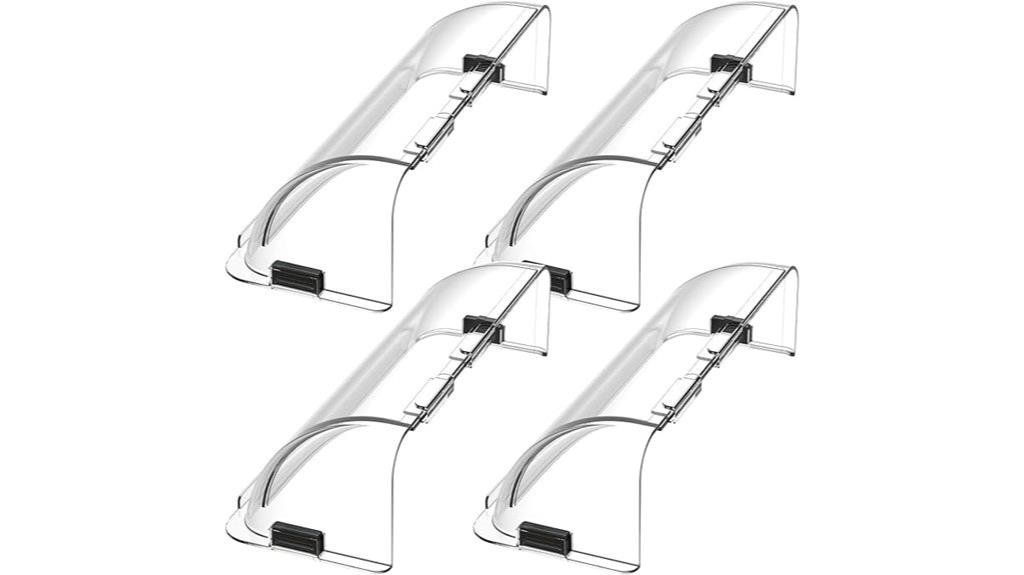
When seeking an effective way to optimize your home’s heating and cooling, the Home Intuition Air Vent Deflector stands out with its adjustable magnetic design. I love how it easily extends from 8.5” to 15”, ensuring a perfect fit on various vents. By directing airflow, it improves energy efficiency, keeps rooms evenly heated or cooled, and reduces strain on my HVAC system. Made from durable plastic with strong magnets, it stays securely in place without damage. The sleek, transparent design blends seamlessly into my decor. Plus, with a 5-year guarantee, I trust it’ll deliver long-lasting performance and savings.
Best For: homeowners seeking an easy, effective solution to improve airflow management and energy efficiency in their heating and cooling systems.
Pros:
- Adjustable from 8.5″ to 15″ to fit a variety of vents perfectly.
- Durable construction with strong magnets ensures secure placement without damage.
- Sleek, transparent design seamlessly integrates with home decor for a low-profile look.
Cons:
- May require occasional repositioning if magnets weaken over time.
- Limited color options could affect aesthetic preferences in some settings.
- Cannot fit vents outside the specified adjustable width range, limiting versatility in some cases.
Aiyufeng Blackout Curtains for Bedroom, 63 Inch Length, 2 Panels
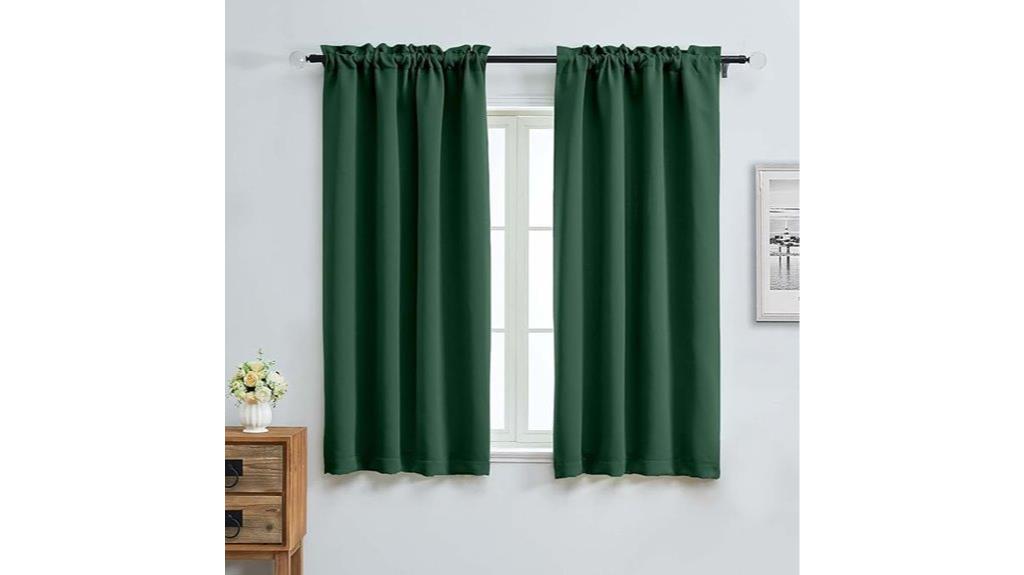
If you’re looking to boost your winter energy efficiency, Aiyufeng Blackout Curtains for Bedroom are an excellent choice, especially with their 63-inch length and two-panel design. Made from high-quality polyester, these curtains feature a three-layer weave with a black middle layer that blocks 85% to 98% of light and UV rays, helping maintain indoor warmth. They offer versatile hanging options—rod pocket or clip style—and can be adjusted for perfect fit. Not only do they enhance privacy, but they also help reduce heating costs by preventing heat loss in winter and blocking heat in summer. Plus, they’re machine washable for easy upkeep.
Best For: those seeking energy-efficient, blackout curtains to improve privacy and temperature control in their bedrooms or living spaces during winter and summer.
Pros:
- Effectively blocks 85% to 98% of light and UV rays, enhancing privacy and darkness
- Versatile hanging options with rod pocket and clip style for easy installation and adjustment
- Made from durable, high-quality polyester with a stylish, matching double-sided color finish
Cons:
- May be too dark for those who prefer more natural light during the day
- Length of 63 inches might not fit very tall windows or high ceilings without customization
- Requires machine washing, which may lead to wear over time if not cared for properly
ThermaCels – Insulating Paint Additive 1 Gallon Package

ThermaCels – Insulating Paint Additive in the 1-gallon package is an excellent choice for homeowners looking to boost their insulation without major renovations. I love that it mixes seamlessly into any paint or coating, so I can enhance insulation on various surfaces easily. Just a quart of this ceramic additive treats a gallon of paint, making it cost-effective. It reduces heat transfer, helping lower energy bills by minimizing heat loss during winter. Best of all, it doesn’t alter the paint’s appearance or properties. This simple addition turns regular paint into a smart, energy-saving solution, making my home warmer and more efficient.
Best For: homeowners and DIY enthusiasts seeking an easy, cost-effective way to improve their home’s insulation and energy efficiency without extensive renovations.
Pros:
- Seamlessly mixes into any paint or coating without affecting appearance or properties
- Significantly reduces heat transfer, lowering energy bills
- Easy to use, with one quart treating one gallon of paint for versatile applications
Cons:
- Requires mixing with paint or coating before application; not a standalone solution
- Effectiveness depends on proper mixing and application techniques
- May add a slight cost increase to paint projects, depending on paint volume
Foam Core Reflective Insulation 18inch x 100ft Garage attic Crawl Space
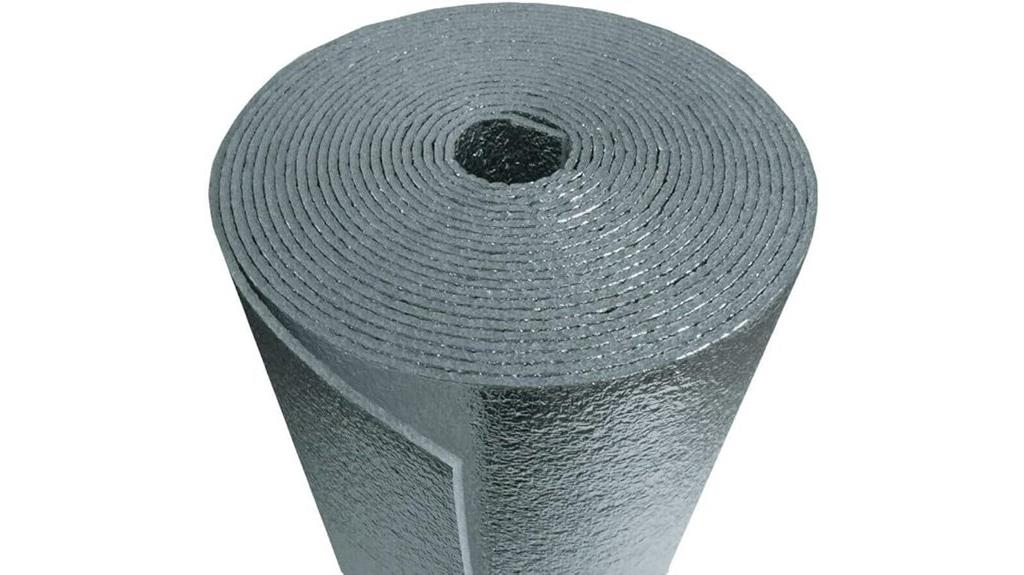
Foam Core Reflective Insulation measuring 18 inches by 100 feet is an excellent choice for homeowners looking to boost energy efficiency in their garages, attics, or crawl spaces. Its reflective layers achieve 96% reflectivity, effectively bouncing radiant heat back into your home. The foam core resists conductive heat transfer, while the polyethylene center adds durability. It’s easy to handle and install, making it perfect for ductwork, metal buildings, or garage doors. This insulation not only improves heat retention but also offers a cleaner, alternative to fibrous materials, helping you cut winter heating costs and stay warmer all season long.
Best For: homeowners seeking an easy-to-install, reflective insulation solution to improve energy efficiency in garages, attics, crawl spaces, and ductwork.
Pros:
- High reflectivity of 96% to effectively bounce radiant heat
- Durable polyethylene center layer for long-lasting strength
- Easy handling and quick installation suitable for various shapes and spaces
Cons:
- May require additional insulation for comprehensive thermal insulation needs
- Less effective in extremely humid or moist environments without proper sealing
- The reflective surface may need protection from punctures or tears during installation
Factors to Consider When Choosing Winter Home Energy-Saving Tips
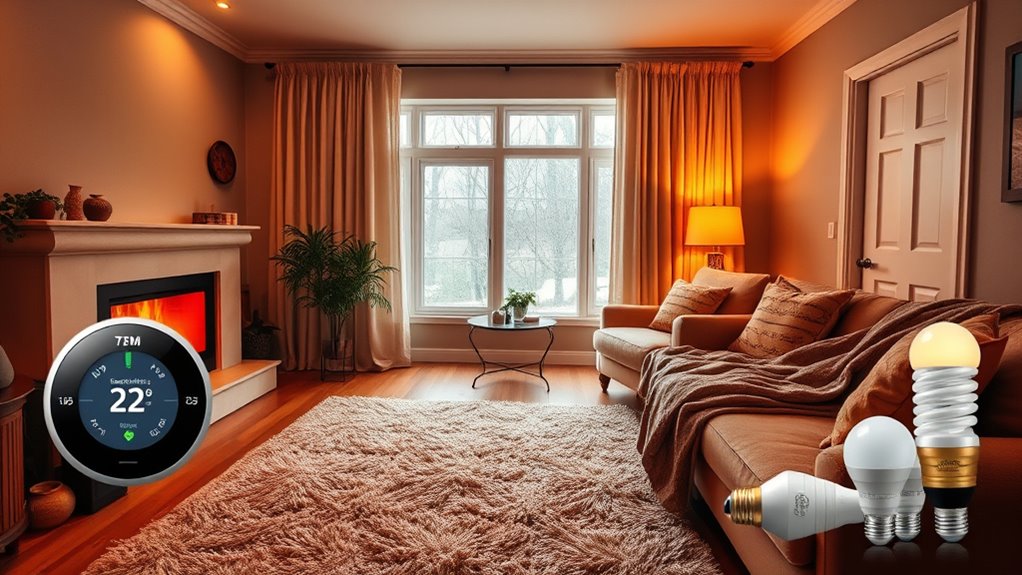
When choosing winter home energy-saving tips, I consider factors like our climate and budget to find practical solutions. I also look at my home’s size, layout, and existing insulation to guarantee the tips are effective. Understanding my energy cost goals helps me prioritize measures that deliver the most savings.
Climate Compatibility
Choosing winter home energy-saving tips that work effectively depends on understanding your local climate. If you live in an extremely cold area, heavy-duty insulation is vital to retain heat. In humid regions, moisture-resistant materials help prevent mold and maintain energy efficiency. Pay attention to seasonal weather patterns, like wind-driven snow or high humidity, and adapt your sealing and insulation accordingly. For example, sealing drafts in a windy climate prevents heat loss, while moisture barriers are essential in humid environments. To ensure your efforts pay off, compare your measures against typical weather conditions and temperature fluctuations in your zone. Selecting climate-appropriate solutions guarantees maximum comfort and energy savings, making your home warmer and more cost-efficient throughout the winter months.
Budget Constraints
Budget constraints play a crucial role in determining which winter energy-saving measures are practical for your home. I recommend focusing on low-cost, DIY insulation and sealing methods, like sealing gaps around windows and doors with weatherstripping or draft stoppers. These simple fixes can greatly reduce heat loss without breaking the bank. Investing in energy-efficient lighting and appliances might have higher upfront costs, but they save money in the long run through lower energy bills. Setting a clear, realistic budget helps you prioritize the most impactful improvements without overspending. Additionally, tracking your energy usage with monitoring tools allows you to see where your money goes and allocate funds to the most effective measures. By balancing costs and benefits, you can maximize savings within your financial limits.
Home Size and Layout
Understanding the size and layout of your home helps determine which winter energy-saving strategies will be most effective. Larger homes require more energy to heat, so insulation and sealing become even more important. Open floor plans can lead to heat loss or gain across multiple areas, making targeted insulation essential. Multi-story homes often experience heat stratification, so managing airflow and adding insulation between floors can boost comfort and efficiency. Homes with complex layouts or many rooms might benefit from zone heating, allowing you to heat only occupied areas. Additionally, the placement and size of windows and doors influence heat retention. Tailoring your energy-saving measures to your home’s size and layout guarantees you maximize warmth while minimizing energy waste and costs.
Existing Insulation
Since proper insulation plays a essential role in keeping your home warm during winter, it’s important to assess the condition and effectiveness of your existing insulation. Good insulation reduces heat transfer through walls, ceilings, and floors, cutting heating costs by up to 20%. Check the R-value of your current insulation—higher R-values mean better thermal resistance. Look for gaps, compression, or damage, as these can considerably diminish insulation performance. Materials like fiberglass, foam, and cellulose each have specific R-values and installation needs; understanding these helps determine if your insulation is adequate or needs replacing. Regular inspections and maintenance can prevent heat loss, keeping your home warmer and reducing energy bills. Making sure your existing insulation is in good shape is a simple, effective step toward winter energy savings.
Energy Cost Goals
Are you setting clear energy cost goals before tackling winter home improvements? Defining specific targets, like cutting your heating bills by a set percentage, helps you stay focused and measure progress. Tracking your monthly energy expenses reveals patterns and highlights areas where you can make adjustments. When your goals align with your financial priorities, investments in insulation or efficient systems become more worthwhile, delivering tangible savings. Regularly reviewing your energy bills and savings results keeps you motivated and allows you to refine your strategies. By establishing concrete, manageable goals, you ensure your efforts are focused and effective, making your home warmer and more cost-efficient throughout the winter. Clear goals turn a general desire to save energy into achievable, measurable improvements.
Maintenance Requirements
When selecting winter home energy-saving tips, considering maintenance needs guarantees your efforts stay effective throughout the season. Regularly inspecting and replacing worn weatherstripping around doors and windows guarantees airtight seals, reducing cold drafts. Keeping insulation materials clean and in good condition helps them retain their insulating properties, preventing heat loss. Scheduling routine maintenance for your heating system ensures it runs efficiently and avoids costly breakdowns. Additionally, checking and updating ventilation systems promotes proper airflow and minimizes moisture buildup, which can compromise insulation. Keeping a detailed record of maintenance tasks and schedules helps you stay on top of these responsibilities, ensuring consistent energy savings. Prioritizing maintenance not only enhances your home’s efficiency but also extends the lifespan of your systems, keeping you warm and saving money all winter long.
Frequently Asked Questions
How Can I Improve Indoor Air Quality While Saving Energy?
To improve indoor air quality while saving energy, I make sure to regularly change my air filters and use a high-efficiency particulate air (HEPA) filter. I also open windows briefly for fresh air exchange, even in winter, to reduce indoor pollutants. Incorporating houseplants helps naturally purify the air, and I avoid overusing humidifiers, which can promote mold. These steps keep my air clean without wasting energy.
What Are the Best Low-Cost Ways to Prevent Heat Loss?
To prevent heat loss on a budget, I seal gaps around windows and doors with weatherstripping or draft stoppers. I also add heavy curtains at night to insulate windows and block cold air. Insulating pipes and vents helps retain heat in key areas, while using rugs over bare floors adds warmth. These simple, low-cost measures make a noticeable difference in keeping my home cozy and energy-efficient during winter.
How Does Window Tinting Affect Winter Heating Costs?
Did you know window tinting can actually lower your winter heating costs? I found that tinting reduces heat loss by blocking chilly drafts and insulating your windows. It’s like giving your home an extra sweater. Plus, you still get natural light without the cold seeping in. Since I started tinting my windows, I’ve noticed my thermostat doesn’t need to work as hard, saving me money and keeping my home warmer.
Are There Eco-Friendly Insulation Options for Older Homes?
Yes, there are eco-friendly insulation options for older homes. I recommend cellulose insulation made from recycled paper or sheep’s wool, which are both sustainable and effective. I’ve used spray foam with plant-based ingredients, reducing environmental impact while sealing gaps. These options improve energy efficiency without harming the planet. It’s a great way to upgrade your home’s insulation while staying eco-conscious and saving on heating costs.
How Can Smart Thermostats Optimize Energy Use During Winter?
Smart thermostats are a game-changer during winter. They learn your schedule and adjust the temperature accordingly, so you’re not wasting energy when you’re not home or asleep. I always say, “set it and forget it”—they allow me to keep my home cozy without overdoing it. Plus, I can control them remotely, ensuring I don’t heat an empty house. It’s a simple way to save money and stay warm.
Conclusion
By following these winter energy-saving tips, you’ll keep your home warmer and your bills lower—no need to channel Dickens’ ghosts for warmth! Insulating, weatherizing, and smart lighting make all the difference. Think of it like crafting your own cozy castle, even if it’s not medieval times. Stay proactive, and you’ll enjoy a snug, cost-effective winter that would make even a Victorian noble envious. Cheers to a warm, wallet-friendly season!
